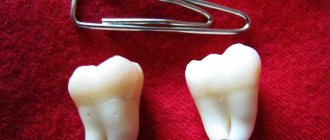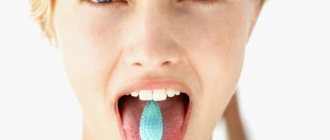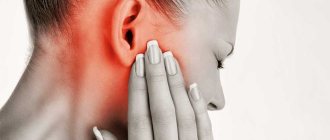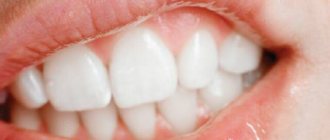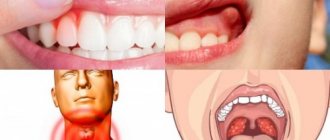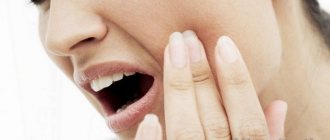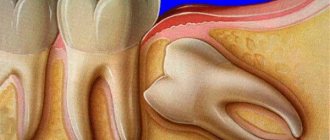Anti-inflammatory drugs for toothache
Anti-inflammatory drugs are more often used than other drugs to treat pain in dental practice. The main groups of painkillers used for toothache:
- Nonsteroidal anti-inflammatory drugs (NSAIDs);
- Analgesics-antipyretics (paracetamol and analgin);
- Opioid analgesics (codeine);
- Local anesthetics (lidocaine, anesthesin).
Different drugs from different groups can be used either individually or in combinations. Drugs from the anti-inflammatory group are most often used orally in the form of tablets or liquid forms; they are much less often used in dentistry in the form of injections and local forms.
Currently, anti-inflammatory drugs for toothache are no longer considered purely symptomatic. The inflammatory process often accompanies many dental and periodontal diseases, so anti-inflammatory therapy, in many cases, will have a pathogenetic direction, that is, aimed at the painful processes themselves, and not at their manifestations.
Types of drugs for toothache
Acute toothache, known in medicine as odontalgia, is one of the most severe and difficult to tolerate. That is why it should be eliminated in a timely manner. As part of her drug treatment, analgesic, antispasmodic and complex drugs are used. Moreover, the choice should depend on the source of pain, the condition of the soft and bone tissues around it.
Accordingly, you first need to conduct the necessary clinical studies, then the doctor must check your medical history and choose the most optimal type of medication.
In exceptional cases, antibiotics can be used; they relieve pain and have a healing effect.
Analgesics affect the central nervous system, reducing the sensitivity of nerve endings near the bone tissue of the tooth. Therefore, the patient simply stops feeling pain. Antispasmodics act by relaxing smooth muscles and dilating blood vessels near them. Accordingly, blood flow is normalized and the wound is quickly restored. Complex drugs are considered the most optimal. The fact is that pain can be caused by any reason. And if there is simply no time to find out, you need to use such means. It remains to understand how to choose them wisely.
Popular over-the-counter anti-inflammatory drugs for toothache
- Ibuprofen is the most popular anti-inflammatory drug today, used as an analgesic and antipyretic. The most famous option is Nurofen, popular due to the abundance of advertising. Adults are prescribed 200-600 milligrams per dose. The drug has been well studied and can be used even in young children. The dose of the medicine is adjusted depending on the age and weight of the patient. Like all other non-selective anti-inflammatory drugs, Ibuprofen is contraindicated in case of ulcerative lesions of the stomach and intestines, pregnancy and bleeding or blood clotting disorders, as well as if the patient has experienced intolerance to acetylsalicylic acid or other anti-inflammatory drugs. In terms of the strength of the analgesic effect, oral Ibuprofen is second only to prescription Ketorolac (Ketanov) and expensive Lornoxicam (Xefocam) among tablets.
- Acetylsalicylic acid (Aspirin) is the first and most famous anti-inflammatory drug. This is a relatively weak remedy, now less often used in dentistry. The usual single dose is one tablet with 325 or 500 milligrams of the active substance.
- Naproxen is the third systemic anti-inflammatory drug approved for over-the-counter sale. Available in the form of 275 milligram tablets. Not used to treat children under 16 years of age.
- Flurbiprofen is a topical anti-inflammatory drug that is part of Strepsils Intensive. One dose contains 8.75 mg of the drug; a maximum of 5 lozenges per day can be used for adults and children over 12 years of age.
When self-medicating with any over-the-counter painkillers, it is important to know and follow one rule: if you need to take the medicine for more than two days, you should definitely consult a doctor.
The use of tablets in the treatment of neuralgia of various types
Have you been trying to heal your JOINTS for many years?
Head of the Institute for Joint Treatment: “You will be amazed at how easy it is to heal your joints by taking every day...
Read more "
Treatment of any ailment takes a considerable amount of time and money. Patients are usually prescribed tablets or ointments for a full recovery.
Cases of neuralgia of various types also require treatment with a whole group of medications that will not only eliminate the causes of nerve problems, but also have a beneficial effect on the body as a whole.
Causes of neuralgia
Getting sick is quite easy. To do this, in a number of sulchai, you don’t even need to perform any actions, for example, just sit in a draft and the nerve will be supercooled. In addition to the unfavorable climate, the development of the disease is facilitated by:
- Bruises and injuries.
- Inflammation occurring in the body.
- Tumors.
- Use of alcohol or drugs.
- Stress and depression.
Any of these reasons can lead to damage to the nerves, which cause severe pain in the area where they are located. Usually the nerve is pinched by the muscles, which are in a state of spasm and cannot function properly.
It is worth noting that neuralgia is rarely accompanied by fever, but this can happen if there is poisoning or an inflammatory process.
How is the disease treated?
It should be noted that there are several types of neuralgia, so treatment may vary slightly from case to case, but in general the principle of treatment is similar. Doctors first try to remove the symptoms of neuralgia, and only then the disease that caused health problems.
Inflammation of the trigeminal nerve
An exception is damage to the trigeminal nerve, since in this case the treatment is carried out starting from the main ailment. For example, neuralgia of this type occurs when:
- caries;
- frontite;
- sinusitis;
- meningitis;
- arachnoiditis;
- brain tumors.
Thus, to get rid of neuralgia, it is necessary to eliminate the disease causing inflammation. For this, doctors prescribe medications that relieve pain and inflammation, such as:
- analgin;
- butadione;
- phenacetin;
- amidopyrine;
- rheopirin;
- acetylsalicylic acid.
These tablets effectively combat the disease, making life easier for the patient in the acute phase of neuralgia. In addition, to consolidate the effect and help the body, various supplements and stimulants are prescribed, for example:
- plasmol;
- vitreous body;
- tablets containing vitamin B complex;
- suksilep;
- finlepsin.
It is interesting to note that previously Finlepsin was used only to treat patients with epilepsy, but recent studies have shown that these tablets can prevent the development of paroxysmal pain or worsening of the disease.
Treatment of neuralgia of other types
If any nerve other than the trigeminal nerve is affected, then its symptoms are treated. For example, occipital and intercostal neuralgia are treated in this way. So, the following types of tablets are used:
- Non-steroidal anti-inflammatory drugs.
- Muscle relaxants and antispasmodics.
- Blockers containing analgesics or corticosteroids.
The use of non-steroidal anti-inflammatory drugs
Treatment of almost any disease today is impossible without the use of this group of medications. Medicines help reduce discomfort and reduce fever if it is present.
The same banned issue for which Ernst fired Malakhov!
Joints and cartilage will be cured in 14 days with the help of ordinary...
However, not all of them are able to help with neuralgia, since the pain is very unpleasant and cannot always be drowned out.
That is why it is necessary to use the latest generation of medicines that have a clear focus on pain suppression, such as:
- naproxen;
- tiaprofenic acid;
- promedol;
- ketoprofen;
- menovazin;
- ketorolac.
In addition, among the old-school drugs, diclofenac shows good results. On the other hand, you should not use medications such as meloxicam or celecoxib for neuralgia, as they do not cope well with this type of pain.
Tablets containing snake or bee venoms are great for relieving pain and inflammation. These types of medications often come in the form of ointments or injections, but they also include apifor, which is sold in tablet form.
However, drugs containing poisons have a number of contraindications. So, they should not be used when:
- heart defects;
- kidney or liver damage;
- fever;
- pregnancy;
- increased sensitivity to poisons.
It is worth noting that the use of injections and pricks will be somewhat more effective than tablets, however, the latter are much more convenient to use and do not require a visit to a medical office, which saves patients time and money.
Use of muscle relaxants and antispasmodics
Since the main cause of neuralgia is muscle spasm, it is necessary to resolve it. This is why doctors prescribe antispasmodics - medications that eliminate the causes of spasms, as well as relax muscles, which leads to a reduction in discomfort.
A particularly good effect is achieved when they are correctly combined with anti-inflammatory drugs, but you should not carry out such treatment at home, as this can lead to intestinal problems.
On the other hand, taking precautions, antispasmodics can be used independently, but after carefully reading the indications for use in the instructions. Tablets in this group include the following medications:
- halidor;
- no-shpa;
- besalol;
- spasmonet;
- papazole
The market supply is extremely large, so the attending physician will select the necessary medications based on the patient’s individual symptoms.
In addition to antispasmodics, doctors can prescribe muscle relaxants, but they can no longer be used without the supervision of a doctor, as they have a number of contraindications. Among the most effective drugs are:
- baclofen;
- sirdalud;
- clonazepam.
Treatment with muscle relaxants occurs only in extreme cases, since their negative effect on the body is stronger than that of antispasmodics. Of course, they suppress neuralgia better, but if there is an opportunity to do without them, then it is worth taking advantage of it.
Blockers and their use
Treatment with hormonal agents, such as corticosteroids, is the most extreme method. If standard pills and medications do not help the patient, then only blocking the source of the disease can drown out the discomfort.
It is precisely because of the peculiarities of the use of drugs that they can only be used under the direct supervision of a vertebrologist or neurosurgeon, who will prescribe the correct dosage and time of use of the drugs.
Treatment of neuralgia is best carried out under the supervision of a specialist, because incorrectly selected medications can only aggravate the disease.
However, it is worth noting that if it is not possible to quickly visit a professional, it is possible to use some anti-inflammatory drugs and antispasmodics to relieve pain.
However, treatment of neuralgia is impossible without the use of a number of other means, such as massage, physiotherapy and electrophoresis, so you should not rely on medications alone, as this may lead to relief of symptoms, but will not eliminate the cause of the disease.
Prescription anti-inflammatory drugs.
This group of medications prescribed by dentists and other specialists includes more than fifty active ingredients, which may have several dozen trade names. There is no point in listing them all; it is enough to know the most commonly used active ingredients and the most common trade names of such products. Most often, dentists recommend:
- Nimesulide (Nimesil);
- Ketorolac (Ketanov);
- Ketoprofen and Dexketoprofen (Ketonal and Dexalgin).
They also sometimes prescribe:
- Meloxicam (Movalis);
- Diclofenac (Voltaren);
- Lornoxicam (Xefocam);
- Celecoxib.
Nimesulide has long been a very popular anti-inflammatory drug in post-Soviet countries, long ago developed in the USA. However, due to the high risk of serious side effects, it was not approved for clinical use there; it is widely used mainly in countries with lagging levels of medical care. The medicine is available in the form of tablets and sachets, which are especially popular due to the common misconception that anti-inflammatory drugs in liquid forms are less harmful to the stomach. According to the instructions, it can be used as a second-line medicine, that is, after a previously prescribed remedy did not have a sufficient effect. The maximum single dose of Nimesulide is 100 mg, the duration of action is 6-8 hours. You can take no more than 200 mg per day. In addition to standard contraindications, it should not be taken for colds, high body temperature, liver disease, or for children under 12 years of age. This remedy is also contraindicated for alcoholism.
Ketorolac (Ketanov) is a drug that is included in many standards of postoperative pain relief. More effective than most similar remedies in the first days of acute pain, it is the optimal remedy for treating pain in the first 5 days after tooth extraction or other painful procedures, such as the installation of a dental implant. Available in the form of 10 mg tablets, the maximum dose is 4 tablets. For severe pain after major operations and jaw fractures, it can be used as injections. It does not affect the rate of healing of fractures, since it does not have the strongest anti-inflammatory effect with a pronounced analgesic effect. It has almost no effect on the temperature reaction, therefore it does not mask hyperthermia during purulent processes. Not used for chronic pain. It has standard contraindications and is used from 18 years of age.
Ketoprofen and Dexketoprofen are anti-inflammatory drugs also used after surgery. In comparative studies, Ketorolac is inferior in pain relief in dentistry. Can be used for chronic pain. Produced in the form of tablets, capsules and powder for solution. One tablet contains 50 mg of ketoprofen or 25 mg of dexketoprofen. The drug is quickly eliminated from the body; after 2 hours the concentration in the blood is halved. The maximum dose is 3 tablets per day.
Much less commonly used are drugs with a pronounced anti-inflammatory effect, popular in the treatment of joint diseases: Diclofenac, Meloxicam and Celecoxib. Diclofenac recently lost its status as the gold standard anti-inflammatory therapy due to an increased risk of heart attacks and strokes. And Meloxicam and Celecoxib deserve attention as medications that can be used for stomach problems - Meloxicam can be taken in the absence of acute ulcers, Celecoxib is a selective drug that does not affect the stomach. Meloxicam is used in tablet form in a single dose of 7.5-15 milligrams. Celecoxib is produced in the form of capsules containing 100 or 200 milligrams of the drug.
How to cure toothache?
If you have problems with your teeth, regardless of whether the patient is suffering from caries or some kind of inflammation, toothache often appears. It can have a different character, including pulsating, aching, cutting. Because of this, the patient cannot do even basic things, since discomfort simply does not allow him to do this. The pain is especially difficult to bear at night, since during this period all sensations intensify significantly. You can relieve the pain with the help of good pharmaceutical products or with the use of available household items. Each of them can show good results, but only if used correctly.
How to cure toothache?
Melissa decoction for treatment
For the medicine, you will need to prepare a special solution that will help not only relieve inflammation and relieve pain, but also protect other teeth from caries, and the oral mucosa from infections. For 400 ml of boiling water you need to take two tablespoons exclusively of the flower part of the plant. Leave the solution for about 1-2 hours, after which you will need to remove all the lemon balm. You can use the home remedy up to 10 times a day in the form of a rinse. Approximately 150-200 ml of solution is taken at a time, and care should be taken that it is approximately +35 degrees, so that there is not a large temperature difference. Treatment in this way can be continued exactly until you can visit the dentist. But you should not exceed the course of treatment for 10 days.
Melissa decoction relieves inflammation and toothache
Attention! Be sure to use lemon balm solution after eating, this way you can not only remove all food debris, but also rinse the affected tooth so that the inflammatory process does not intensify.
Clove oil for tooth pain
It is best to take only pharmaceutical oil, since it contains the required concentration of active substances. If you prepare the clove product yourself, you may end up getting too strong a concentration and end up burning your gums and oral mucosa. For treatment, you only need to take a sterile swab or cotton wool and blot it with a small amount of the product.
To relieve toothache, it is best to take only pharmaceutical oil
If too much oil has leaked out, it is better to squeeze out the swab so as not to cause an overdose of the active substance. Before placing a tampon on your teeth, you should be sure to brush them, as this will enhance the final result. The tampon is applied only to the sore spot for 5-20 minutes; here it is necessary to take into account the intensity of the pain syndrome and the patient’s response to treatment. If it burns too much, it’s better to get some cotton wool. The procedure is carried out within 3-7 days up to 5 times in 24 hours.
Attention! Instead of cloves, you can also use mint and fir, but keep in mind that mint oil is considered very allergenic. Because of this, it is not recommended for use in childhood and during pregnancy.
Garlic against oral diseases
Garlic can be used to relieve pain and to prevent any infections and inflammations
This product can be used not only to relieve pain, but also to prevent any infections and inflammations. If the patient is suffering from pulpitis or pain of any other kind in the oral cavity, you need to peel a small clove of garlic and apply it to the sore spot. You can keep it for 15-30 minutes if it does not cause significant discomfort.
If this method of using garlic does not suit you, you can make a paste from it. After this, it is placed in gauze and applied to the affected area. Both types of procedures are repeated up to 5 times during the day. You can use this method for 10 days.
Plantain for dental treatment
To prepare an effective remedy, you need to take a tablespoon of plantain; usually only the leafy part of the plant is taken. It can be purchased at the pharmacy; there is no need to chop the plantain. This amount of product is poured into 200 ml of boiling water, boiled for 10 minutes, filtered and the solution is brought back to the original volume. Once it reaches a temperature that is pleasant for rinsing, it can be used. Plantain is used at least 10 times a day for as long as the patient needs until he can go to the dentist.
Plantain infusion is an effective remedy for toothache
To get a faster result, plantain can be mixed with chamomile in proportions of 1 to 1. For treatment, a tablespoon is also taken and prepared in the manner described above. When mixed with chamomile, the rinse solution should not be used more than 10 times per day. The maximum course of treatment is two weeks.
Attention! The peculiarity of this method of treatment is the possibility of its frequent use. If the pain is very acute and difficult to bear, you can rinse your teeth every 10 minutes. Plantain also goes perfectly with any other folk and medicinal remedies.
Beetroot against discomfort
Beets are good for relieving toothache
This remedy also helps relieve toothache, but you should be careful, as beets can burn the mucous membranes and gums, so they are used only in the form of compresses. To treat, you will need to take a small piece of fresh vegetable and mash it into a puree. Approximately 2-3 g of finished vegetable product is taken per diseased tooth. It is wrapped in sterile gauze or bandage and applied to the sore spot. The procedure is carried out for 5-15 minutes; if significant discomfort occurs, treatment can be interrupted earlier. The procedure can be repeated up to 5 times during the day. The course of treatment itself can be continued for up to 10 days, unless the patient has any irritation or burns.
Attention! For severe toothache, adult patients are allowed to apply a raw piece of beetroot directly to the painful tooth. But at the same time, you should listen to your feelings and, if irritation occurs, immediately remove the vegetable from your mouth.
Video - How to treat toothache with folk remedies
Drug treatment of toothache
Voltaren
The drug Voltaren in tablet form
The medicine is available in several pharmacological forms; to suppress toothache, you need to take a tablet form. It provides the fastest results for this type of pathology. The main active ingredient of the drug is diclofenac, which is an anti-inflammatory component. To relieve any type of discomfort, including gum inflammation, you should take 100-150 mg of Voltaren per day. Therapy should not be continued for more than five days; in exceptional cases, it is allowed to extend the treatment to one week.
Attention! In exceptional cases, a medicinal product containing diclofenac may be taken during pregnancy. The safest period is the second trimester. When using such medications in the third trimester, there is a high probability of suppressing uterine contractions, which can lead to an emergency caesarean section.
Diklak
Drug Diklak
The medication is also available in tablet form. If pain occurs in the oral cavity, the drug is taken no more than three times a day, the maximum dose per 24 hours is 150 mg of the active substance. In case of urgent need, the product can be used in childhood, but only from 6 years of age. In this case, the dosage must be calculated individually for each patient. It is a maximum of 2 mg per kilogram of the baby’s body. From the age of 16 or when the child reaches a body weight of 50 kg, Diclak can be taken in adult doses, if there are no diseases of the urinary system. The maximum course of taking tablets is 5 days.
Lincomycin
The drug Lincomycin in tablet form
The medicine comes in the form of tablets and ointment, both of which can be used to suppress toothache, but it is better to choose the tablet form. If pathology occurs, you can take the medication regardless of meals, but it is advisable to do this an hour before or after meals. Mixing Lincomycin with food significantly inhibits its effects. This antibiotic is taken at a dose of 500 mg of the drug at intervals of 8-12 hours. You should not take an antibiotic against oral pain for more than 7 days. If there is no suppuration, you should not take Lincomycin for more than three days.
When using the ointment, make compresses. To do this, squeeze out a small amount of ointment, literally the size of a small pea, onto a cotton pad or piece of gauze. Lincomycin is applied to the tooth for 10 minutes. When treating a diseased tooth, you should not swallow the resulting saliva, so as not to accidentally provoke poisoning or intestinal disorder. Applications are made only twice and no more than three days.
Nalgesin
When ingested, Nalgesin has a good analgesic effect.
The drug contains naproxen. When ingested, it has a good analgesic effect and also helps relieve mild fever. The medication is strictly forbidden to be given to children under one year of age. The dosage of Nalgesin for patients over 16 years of age is one tablet. The maximum recommended safe therapeutic dose is two tablets. But in exceptional cases, to relieve severe pain, you can take up to 825 mg of naproxen. Take Nalgesin for no more than three to five days.
Arthrofoon
Drug Artrofoon
This drug is taken to suppress pain caused by joint diseases. But in the absence of other medicines, you can drink it for dental problems. The dosage of the drug is 2 tablets, which must be thoroughly dissolved in the mouth. You can take this dose twice a day. If the pain is severe or intensifying, Artrofoon can be taken up to 4 times, also two tablets. You should not take the medication for more than three days, but it is better to replace it at the first opportunity with a remedy specifically against toothache.
Movalis
Movalis for intramuscular administration
This remedy is also created specifically to suppress toothache and oral discomfort. The medication is available in the form of a solution for intramuscular administration. Injections are required only during acute attacks, since the rest of the time it is better to take tablets or capsules. The dosage for tooth pain is 7.5 mg of the active substance. The instructions allow doubling Movalis, but this should not be done for this pathology. If you have dental problems, you should not take Movalis for more than 1-3 days.
Tsifran
The drug Cifran against toothache
The drug belongs to a class of antibiotics that can be taken for toothache, especially if it is accompanied by inflammation and pus. Tsifran helps reduce pain, stop the spread of infection, reduce tooth sensitivity and prevent germs from spreading to adjacent teeth and gums. Treatment involves taking only 500 mg of the active ingredient no more than twice a day. For problems in the oral cavity, Cifran should not be taken for more than 3 days if there are no problems with purulent neoplasms, and 10 days if there are any.
Cost of medicines
DrugImage Price in the Russian Federation in rublesPrice in the Republic of Belarus in rublesPrice in Ukraine in hryvnias
| Voltaren | 270 | 9 | 110 |
| Diklak | 100 | 3,2 | 41 |
| Lincomycin | 100 | 3,2 | 41 |
| Nalgesin | 170 | 6 | 70 |
| Arthrofoon | 400 | 13 | 164 |
| Movalis | 600 | 19 | 246 |
| Tsifran | 300 | 10 | 123 |
Massage procedures for toothache
If you are a follower of alternative methods of treatment or do not have drugs at hand and the ability to prepare a home remedy, you can turn to the following methods:
- it is necessary to press on the affected gum with your ring finger, and it is recommended to carry out such manipulations only with the right hand and through the cheek, the duration of the pressure itself should not be less than one minute, repeat this action an unlimited number of times;
- you can also press for four minutes on the upper corner of the nail plate on the index finger, if it hurts on the left, select the left finger, if on the right - accordingly, the right one, the procedure can also be carried out an unlimited number of times;
- with all the fingers of your left or right hand, it all depends on which side the tooth hurts, you need to apply their pads to the sore gum through the cheek, hold it with your hands until the pain begins to recede;
- press on the artery with your thumb, but only on the side on which the tooth is destroyed or the gums hurt.
Gum massage will help with toothache
Attention! Do not put too much pressure on the gum or massage it when there are obvious signs of suppuration or swelling. Such manipulations can ultimately lead to more serious consequences and the spread of inflammation further.
If, when using the described medications and methods of removing toothache, it does not subside within 2-3 days, you should urgently consult your doctor. The cause may be hidden in severe pathologies, including granulomas, cysts, large accumulations of pus or deep pulpitis. With such diseases, it is necessary to quickly take the necessary therapeutic measures, since the pain cannot be relieved until they are eliminated.
Video - Methods for eliminating toothache
expertdent.net
How to reduce the side effects of anti-inflammatory drugs.
There are a few simple rules that will help minimize the likelihood of side effects.
The first and most important thing is to carefully study the instructions before taking the medicine . There is no need to start treatment if there are contraindications, and you also need to take into account the peculiarities of using drugs for various concomitant diseases and the peculiarities of their interactions with other drugs.
also advisable to take medications after meals , and this is done not only to reduce irritation to the stomach. Most anti-inflammatory drug molecules are lipophilic and their absorption is enhanced in the presence of fat.
You also need to use the minimum dose of medication to achieve an effect, because often half the maximum dose may be enough. It is better to take these medications in a smaller dose, increasing the frequency of use.
Most anti-inflammatory drugs slow down the blood clotting process and can increase bleeding , so it is not advisable to use them before tooth extraction or implant installation, if there is a need to take painkillers - then in such cases it is better to limit yourself to paracetamol.
You cannot take two anti-inflammatory drugs at the same time , with the exception of topical forms. And if undesirable side effects of the drug develop, you should inform your doctor about this and skip subsequent doses of the drug. And of course, the effectiveness of treatment depends not only on compliance with the dosage regimen of medications, but also on compliance with all necessary measures, including diet, general regimen and exclusion of provoking factors.
Source: mamenazametku.ru
Movalis: instructions for use of tablets
Movalis is a non-steroidal anti-inflammatory drug from the oxicam group, which has analgesic, antipyretic and anti-inflammatory properties. The drug is used to treat arthritis and osteoarthritis. The effects are due to inhibition of prostaglandin synthesis with selectivity for COX-2. The tablets can be taken once daily with food due to their long half-life. The most common potential side effects include stomach upset and headache. As with other non-steroidal anti-inflammatory drugs, serious side effects are possible.
Indications for use
Movalis 15 mg costs approximately 700 Russian rubles.
Movalis is primarily used to treat pain and inflammation caused by osteoarthritis, rheumatoid arthritis, ankylosing spondylitis and gout, as well as post-operative dental pain. Well-known NSAIDs are, for example, ibuprofen or diclofenac. However, Movalis belongs to a subgroup of NSAIDs called coxibs, also known as COX-2 inhibitors, which have a slightly modified mode of action.
Short-term use of the drug occurs when patients respond to classic NSAIDs with gastrointestinal side effects, as MOvalis is considered to be better tolerated.
Instructions for use
According to the instructions for use, the drug can be taken in a single daily dose of 0.0075 and 0.015 g. Movalis tablets should be swallowed with water or other liquid during meals in accordance with the manufacturer's recommendations.
Your doctor will tell you how to inject Movalis. He will also tell you what Movalis helps with. It is not recommended to inject the drug intramuscularly without consulting a specialist. The dose is always based on the indication. Acute gout may require a higher dose. The effect usually occurs in about an hour and lasts for about 24 hours. The drug can be taken regardless of meals, but its effect is faster on an empty stomach.
Contraindications, side effects, overdose
- Hypersensitivity to the active substance or other components
- Bleeding in the stomach or intestines
- Patients who were allergic to NSAIDs or acetylsalicylic acid.
Because the consequences of decreased COX-2 activity during pregnancy are poorly described, meloxicam should not be administered to pregnant women. Even while breastfeeding, meloxicam should be avoided as this substance passes into breast milk.
With a daily dose, gastrointestinal side effects occur - diarrhea, constipation and other digestive disorders. According to the manufacturer's statistics, this dose very rarely caused ulcers or other dangerous complications.
Compared with naproxen, the drug dose was significantly less likely to be associated with gastrointestinal complaints. In contrast, there were no significant differences from diclofenac. The rate of adverse reaction with increasing dose is significantly higher.
Meloxicam also sometimes causes skin reactions (exanthema, urticaria, rarely photosensitivity), stomatitis, headache, dizziness, edema, increased blood pressure, flushing, hematological changes (anemia, leukopenia, thrombocytopenia) and increased liver enzymes. Renal dysfunction is rare. There were no isolated cases of asthma attacks.
Although it is unlikely to be documented, it can be assumed that meloxicam may cause the same interactions as other oxicams. In particular, it should not be combined with other non-steroidal anti-inflammatory drugs due to the increased risk of gastrointestinal side effects.
It is recommended to abstain from alcoholic beverages and food while taking the active substance. In addition, oral anticoagulants should not be taken at the same time as the medication.
Renal function may deteriorate if Movalis is administered together with other NSAIDs, diuretics, ACE inhibitors or AT-II inhibitors. To do this, you should carefully monitor the therapy.
It is recommended to refrain from taking the drug at the same time as acetylsalicylic acid (ASA), for example, contained in aspirin. Because it leads to an increased risk of stomach or intestinal bleeding. Some contraceptives should be avoided, namely those containing the active substance ethinyl estradiol. Otherwise, it may actually lead to, for example, venous thromboembolism.
Self-medication is strictly not recommended. Before use, consult a doctor.
Movalis - description: pay attention to side effects
All over the world people suffer from pain. Pain especially often accompanies diseases of the spine and joints. In this case, they become chronic. Non-steroidal anti-inflammatory drugs (NSAIDs), which include Movalis, help relieve or partially reduce such pain.
How does the action of movalis differ from the action of other NSAIDs?
NSAIDs include medications that relieve or reduce signs of inflammation, that is, they have anti-inflammatory, analgesic and antipyretic properties. The mechanism of action of traditional NSAIDs (aspirin, indomethacin, ibuprofen, butadione, diclofenac) is that they prevent the release of prostaglandins - biologically active substances that take an active part in the formation of the inflammatory process. This happens by suppressing the enzyme involved in the formation of prostaglandins - cyclooxygenase (COX).
But all traditional NSAIDs have significant side effects - they irritate the gastric mucosa, leading to the formation of ulcers, and reduce blood clotting, leading to bleeding with prolonged use. It turned out that this happens because prostaglandins are involved not only in inflammatory processes, their role in the body is much more significant, in particular, they protect the gastric mucosa from various mechanical and chemical irritations.
During the research, it turned out that COX can be divided into COX-2, which suppresses the formation of prostaglandins involved in the inflammatory process, and COX-1, which suppresses the formation of prostaglandins that protect the gastric mucosa and blood clotting processes.
The first drug that suppressed the effect of mainly only COX-2 was nimesulide. Movalis (international nonproprietary name - meloxicam) also belongs to the latest generation of NSAIDs, which act primarily on COX-2. It has pronounced anti-inflammatory and analgesic properties and less pronounced antipyretic properties. Movalis also has side effects (irritation of the gastric mucosa and increased bleeding), but its degree is much less than with traditional NSAIDs. This allows you to use Movalis in longer courses under the supervision of a doctor and laboratory tests.
Movalis is produced by the pharmaceutical company Boehringer Ingelheim International GmbH (Germany) in the form of an injection solution in ampoules, tablets for oral administration and rectal suppositories.
Who is prescribed movalis
Movalis is prescribed for mild and moderate pain (severe pain requires the use of narcotic drugs) that occurs against the background of long-term inflammatory and degenerative-dystrophic (metabolic) processes:
- in the spine – ankylosing spondylitis (it is based on an allergy to one’s own tissues), osteochondrosis;
- in joints - arthritis (inflammation of the joints), arthrosis (degenerative-dystrophic changes in the joints), rheumatoid arthritis (an infectious-allergic disease with an allergy to the body’s own tissues);
- for any other diseases accompanied by pain, for example, toothache, earache.
Who should not be prescribed Movalis?
Taking Movalis is contraindicated in case of individual intolerance to the components of the drug, ulcerative lesions of the gastrointestinal tract in a state of exacerbation, severe diseases of the liver, kidneys and cardiovascular system with dysfunction of these organs, in any diseases accompanied by a blood clotting disorder. In addition, Movalis should not be used during pregnancy, while breastfeeding and under the age of 15 years.
Rectal suppositories with Movalis should not be used for inflammatory processes in the rectum and anus, as well as for bleeding.
Side effects of Movalis
Movalis can have side effects on a number of organs and systems:
- on the organs of the gastrointestinal tract - this manifests itself in the form of nausea, vomiting, diarrhea and constipation, flatulence, abdominal pain, heartburn, irritation (even the formation of ulcers) of the mucous membrane of the stomach and small intestine, internal bleeding;
- on the liver and biliary tract - liver dysfunction;
- on the circulatory system – increased heart rate, swelling, high blood pressure;
- on blood - a decrease in the number of leukocytes in the blood (decreased immunity), red blood cells (anemia) and platelets (tendency to bleeding);
- on the kidneys - decreased function;
- on the central nervous system - lethargy, malaise, decreased performance, headache, dizziness, depression, disturbances of consciousness;
- allergic reactions.
Movalis has much fewer side effects than other NSAIDs, however, they do occur, so only a doctor should prescribe this drug.
Galina Romanenko
Article tags:
www.womenhealthnet.ru
Analogs
Analogues of Movalis, which are cheaper: Algesikam and Loxidol.
Algesikam
, LLC for Sanveza Lab. GmbH, Romania/Austria
Price – from 200 Russian rubles
Description – an analogue of Movalis in tablets, which are used to quickly reduce attacks of pain
Pros – reduces inflammation and pain
Cons – sometimes causes dizziness, gastrointestinal bleeding and digestive disorders
Loxidol
Manufacturer – Rompharm Company S.R.L., K.O. for World Medicine Ltd, Romania/Georgia
Price – from 220 Russian rubles
Description – a substitute for Movalis, which is used for the treatment of pain syndromes of various etiologies
Pros – quickly reduces the intensity of pain and local as well as systemic inflammation
Cons – increases the risk of developing stomach ulcers and cardiovascular diseases
Source: lekhar.ru
Movalis: will save you from pain and inflammation in the bones, build cartilage, but there are many side effects and contraindications...
The main actions of Movalis are a powerful anti-inflammatory and a good pain reliever . But the main thing is the literal restoration of cartilage , in my case, intervertebral cartilaginous discs. And these tablets are recommended especially for problems with bones, cartilage, joints , in particular the spine. My intervertebral hernias are usually like this, ugh, ugh, ugh, they don’t cause pain, but once a year it happens that I have to lie for a week or more with almost no movement. It was at one such moment that my sister advised me to try Movalis; the doctor prescribed it to her for classic but severe lower back pain.
Movalis is not a cheap thing , but not incredibly expensive either, closer to 500 rubles. I bought 7.5 mg for myself, but there is also a stronger dose available in 1 tablet .
The tablet begins to act 20 minutes after administration, gradually increasing up to an hour. A serious problem will not be removed in one dose; I had to take it for 4 days . I took 1 tablet a day, according to the instructions, but the tablet was not enough for a full day of pain : after about 15-18 hours, my back began to ache, but not nearly as much as without Movalis.
Only after these 4 days did I get back on my feet and almost run . Otherwise, I could have lain there, as usual, for 9-10 days.
A huge list of side effects, contraindications, interactions with other medications . The second main idea, clearly stated in the instructions -
...the lowest possible doses should be used and the duration of use should be minimized.
So this is it: unless absolutely necessary and when there are other options, it is definitely better not to take Movalis. The stomach with gastritis reacted very poorly , although not with the most severe pain, as sometimes happens: but still “filled up” with Phosphalugel, warm milk and homemade yogurt.
The tablets are medium-sized, yellow, thin, strangely shaped - like a butterfly with almost open wings. Smooth, easy to swallow . It is easy to break in half - there is a special depression in the middle. The downside is that they crumble in your hands along the edges , so be careful when squeezing them out of the blister.
A separate advantage is that the drug is non-steroidal.
I still have a pack of Movalis in reserve, but I wait until the last minute, trying not to drink. And so far I have coped this way, but so far such pain has not recurred.
Addition: not so long ago, when mentioning Movalis, I heard from 5 doctors (emergency room, clinic, hospital) the following, I quote: “No, you don’t need Movalis,” but also “You prescribed for yourself what a neurologist would have prescribed for you.” At the same time, why not, everyone is silent, like partisans. And despite the fact that I was discharged from the hospital with untreated swelling on the spine due to a huge hernia, only a full course of Movalis 15 mg was completed to treat the swelling and severe attack - this was after IVs, after a course of Xefocam 8 injections, a course of Deso injections. (I don’t remember), a hormonal drug, long courses of Ketorol and Katadolon tablets.
Source: irecommend.ru
What really helped you with severe toothache?
Do not offer a dentist, or only from him. They put me on medicine to “kill” the nerve – I’ve been dying for half the night already, damn it.
If there is medicine, just wait until the morning and go to the doctor. You can go to the ambulance and they will give you an injection.
It helped to rinse with warm water salt + soda, or, believe it or not, put a piece of lard on a sore tooth and hold until it subsides
The administration of the Woman.ru website does not evaluate recommendations and reviews about the treatment, drugs and specialists discussed in this thread. Remember that the discussion is being conducted not only by doctors, but also by ordinary readers, so some advice may not be safe for your health. Before any treatment or taking medications, we recommend that you consult a specialist!
Try the painkiller Nise, it is without a prescription. It helped me after a difficult number eight removal.
New features and design have appeared for the version of the Woman.ru Forum on computers. Tell us, what are your impressions of the changes?
Dexalgin. Everything else didn't work.
Tempalgin helped me the most. Nurofen and Ketanov are somehow not right, although Ketanov is recommended, it didn’t work for me.
+ apply cold to your cheek (wrap a pack of butter or milk from the freezer in a towel and apply it to your cheek). It also helps me to snort a little cognac
Author, no one now puts medicine to kill the nerve. Don't make things up.
This was 20 years ago.
ketanov. In general, my doctor always says that if you have problems, call her right away and she will tell you what to do.
Author, no one now puts medicine to kill the nerve. Don't make things up.
This was 20 years ago.
That's it. As they say, what are you talking about, mom? Now the nerve is removed immediately. There are no exceptions. The only possible option was that there was inflammation, they removed the nerve, they didn’t immediately clog the canal, they put medicine in to relieve the inflammation. But in this case there is practically no pain anymore. So, think before you write about nerve and medicine
Ibuprofen. Ketanov did not help.
Nemisil. The best remedy for everything. It will put you back on your feet in an instant, but this is a very deceptive feeling. Your body still feels bad, but you feel healthy.
This is me, the Author, no one now puts medicine to kill the nerve. Don't make things up.
This was about 20 years ago. That's it. As they say, what are you talking about, mom? Now the nerve is removed immediately. There are no exceptions. The only possible option was that there was inflammation, they removed the nerve, they didn’t immediately clog the canal, they put medicine in to relieve the inflammation. But in this case there is practically no pain anymore. So, think before you write about nerve and medicine
they put it down. Why remove it right away, if you can remove a meter-long nerve in 2 days, why pull it alive? freezing still won’t numb the pain 100%. I wouldn't give in right away
Novigan is good, I use it for teeth and headaches, without a prescription
Don't throw slippers, though. a glass of vodka in one gulp. But this is if you don’t go to the doctor in the morning and don’t go anywhere at all. I had this happen about 20 years ago: I had a toothache before the weekend, there was no money for a paid doctor, and there were no dentists on every corner. I stupidly didn’t take Analgin, I toiled half the night until my husband poured the “medicine” into me. Maybe because I practically don’t drink at all, especially vodka, I was knocked out immediately and for a long time, and when I woke up, the pain was already tolerable, I was able to wait until Monday. I repeat, I do not promote drunkenness))
Do not offer a dentist, or only from him. They put me on medicine to “kill” the nerve – I’ve been dying for half the night already, damn it.
They haven’t done this for a long time, they remove the nerve right away, go to another dentist
Irina This is me, the author, no one now puts medicine in order to kill the nerve. Don't make things up.
This was about 20 years ago. That's it. As they say, what are you talking about, mom? Now the nerve is removed immediately. There are no exceptions. The only possible option was that there was inflammation, they removed the nerve, they didn’t immediately clog the canal, they put medicine in to relieve the inflammation. But in this case there is practically no pain anymore. So, think before you write about the nerve and the medicine. Why remove it right away, if you can remove a meter-long nerve in 2 days, why pull it alive? freezing still won’t numb the pain 100%. I wouldn't give in right away
Pharmaceutical herbs against toothache
Sage
This product is used as a rinse. To do this, you need to take a tablespoon of herb with a small heap for a glass of boiling water, about 5 g of the mixture. It is brewed for a quarter of an hour and used for rinsing. Repeat the procedure up to 5 times a day. In this case, you should prepare a fresh sage solution for each new rinse, since the substances necessary for pain relief quickly evaporate. Sage should not be mixed with other herbs. If it is necessary to use them simultaneously, it is necessary to maintain a 20-minute interval between rinses. You can only use regular herbs, without nutmeg or other additives.
Video - 5 recipes for treating toothache
Alcohol infusion of calendula
Also used for therapeutic rinses. Quickly relieves inflammation and swelling, which helps get rid of pain. To prepare the medicine, you need 200 ml of boiled water, its temperature should be approximately +40 degrees, add 5 ml of calendula solution. You can rinse a sore tooth up to three times a day. If you are hypersensitive, you can try adding only 2.5 ml of alcohol solution. Do not use during pregnancy or childhood. More suitable for combination treatment, eliminates only moderate pain.
Attention! Like any other medicine, pharmaceutical herbs can cause an allergic reaction. To prevent this from happening, you should carefully monitor your body's reaction. If nausea or swelling occurs that is not associated with toothache, it is better to stop using the herb.
It is worth understanding that the use of any medications is only a temporary measure. It is imperative that, as soon as the opportunity arises, you need to immediately seek advice from a good dentist. At the same time, you cannot suppress toothache for a long time in childhood and during pregnancy. When using the medications described, you must carefully observe the dosage of the medications and not exceed therapeutic doses.
Dosage forms of the drug
The manufacturing company produces the medicine in several dosage forms: these are tablets
for oral administration,
rectal suppositories
,
solution for intramuscular administration
and
suspension
.
Movalis injections can stop the pain most quickly and effectively
, because the injection of the drug is 100% carried by the blood and relieves pain within an hour. However, intramuscular injections of Movalis are advisable only at the initial stage of treatment, because, like all non-steroidal anti-inflammatory drugs administered intramuscularly for a long time, they can provoke muscle necrosis.
Movalis in tablets is a reliable and safe drug; after you relieve acute pain with injections, then take the tablets, this step-by-step system allows you to reliably cope with pain. Suppositories and suspensions act in the same way as tablets. If you have rectal disease, you should avoid using medications administered rectally.
Whatever dosage form of the drug you take, know that the daily dose should not exceed 15 mg.
There is a cheaper analogue of Movalis - this is Meloxicam
, its action is no different from the more expensive one, just few people know about its existence. By the way, the active ingredient of Movalis is meloxicam.
Pain in the jaw joint: find out the cause and eliminate it
Pain in the jaw area has many causes. You should not put off visiting a doctor or wait for it to go away on its own. It is recommended to visit a specialist as soon as possible. This is a serious symptom that requires mandatory treatment, and in advanced cases, surgery.
Causes of pain
Why does the jaw joint hurt? Pain can be caused by various factors.
Injury
The temporomandibular joint hurts due to injury. In most cases, malocclusion leads to injury to the jaw joint. Pain may also occur if:
- there was a bruise in the jaw area with the appearance of hematomas;
- a fracture of the jaw, which causes a person severe pain with the inability to move the jaw;
- dislocation, which is accompanied by pain when opening or closing the mouth.
TMJ pain dysfunction syndrome
Full name of the disease: temporomandibular joint pain dysfunction syndrome. Pain occurs due to a violation of symmetry. Deformation occurs in one of the joints and, as a result, displacement of the jaw occurs. Untimely treatment leads to asymmetry and disturbances in jaw movement in other directions.
Painful dysfunction of the temporomandibular joint appears due to:
- muscle strain;
- abuse of solid foods;
- malocclusion;
- high abrasion of dental tissue;
- injuries;
- mistakes made by doctors when making prosthetics or filling teeth;
- myositis;
- contracture;
- myalgia.
Osteoarthritis
The temporomandibular joint hurts due to osteoarthritis. The disease is diagnosed in older people when there is wear and tear on the jaw joints. Osteoarthritis can be caused by arthritis or poor-quality dentures. In a person at the initial stage of the disease, when moving the jaw, clicks or a slight crunch are observed. There is stiffness in the morning. After 6 months, the disease covers the entire joint, causing frequent headaches, pain in the eye area, tingling and slight numbness of the facial skin, and significant hearing loss.
Osteomyelitis
The disease provokes a purulent inflammatory process that occurs in the TMJ. Of course, the jaw joint hurts. Most often, the cause of the disease is pulpitis or caries, when there are infectious foci in diseased teeth. A person experiences swelling, severe pain, and inflammation of the lymph nodes in the neck. A toothache appears, radiating throughout the entire jaw. Osteomyelitis requires immediate medical attention, as there is a high risk of developing an abscess and sepsis. The doctor removes the diseased tooth and prescribes a course of antibacterial drugs.
Read more about this disease, its treatment and prevention in our article.
Arthritis
Pain in the jaw joint when chewing can occur due to arthritis. Arthritis of the jaw joint is divided into several types:
- traumatic, which is characterized by mechanical damage;
- rheumatoid, which is allergic in nature and appears when infected with staphylococcus and streptococcus;
- purulent, appearing due to hypothermia, flu and tonsillitis.
Arthrosis
If the maxillofacial joint hurts, then more often it is arthrosis. The TMJ is damaged, which is characterized by severe, aching pain. Arthrosis also has the following symptoms:
- a crunching sound is heard when moving the jaws;
- severe pain is felt when chewing food;
- a person complains of stiffness in the jaw area in the morning.
Diseases of blood vessels and nerves
Pain in the temporomandibular joint appears due to disturbances in the quality functioning of the peripheral nerves and blood vessels in the jaw. For this reason, painful sensations occur when moving the mouth. The pain radiates to the larynx, tongue, pharynx.
Fracture
In case of a fall, impact or other injuries, the jaw may be fractured and, as a result, the jaw joints will then hurt. The main symptom is severe pain, inability to move the jaw, speak or chew food. With a fracture, the tongue may retract. If you do not start timely treatment, there is a risk of tooth alignment. In case of injury, surgery is performed to fix the bones in a normal state.
Cranial neuralgia
When the maxillary joint or lower joint hurts, this also signals neuralgia. The appearance of the disease provokes inflammatory processes in the nerves of the skull. The disease is characterized by severe twitching pain, localized in the lower jaw, glossopharyngeal nerve, and the area from the chin to the temples.
Neoplasms
If your jaw joints hurt, it is possible that something is pressing on them. Pain can be caused by benign tumors:
- osteoblastoclastoma;
- adamantinoma;
- osteoma.
Malignant formations:
- sarcoma;
- cancer.
Symptoms
In case of painful sensations of the TMJ, the main additional symptoms indicating the disease are identified:
- crunch;
- clicks;
- grinding of teeth;
- jaw displacement;
- pain in the ears, neck, facial muscles;
- dizziness;
- hearing problems;
- visual disturbances;
- disorientation in space.
Diagnostics
When the mandibular joint hurts, they look for the cause and treat it, not the symptom.
Before prescribing treatment, the doctor performs diagnostic procedures:
- general blood and urine analysis;
- test for urea and protein levels;
- CT;
- radiography;
- MRI;
- arthroscopy;
- diagnosis of synovial fluid.
Jaw joint pain: treatment
Each cause must be treated individually. Let's give an example of the most common cause of pain in the jaw joint - dysfunction. For TMJ dysfunction, the doctor prescribes a comprehensive treatment consisting of the following stages:
- Immobilization. If the jaw is injured, the doctor will reduce the dislocation or immobilize the jaw if the patient suspects a fracture.
- Drug therapy. The doctor selects a set of medications for the patient.
- Analgesics: Paracetamol, Nurofen, Spazmalgon.
- Anti-inflammatory drugs: Nimesil, Diclofenac, Prednisolone.
- Antibacterial drugs: Tetracycline, Amoxycycline.
- Antifungal agents: Fluconazole, Nystatin.
- Cytostatics: Sulfasazalin, Methotrexate.
3. Physiotherapy.
- UHF;
- phonophoresis;
- electrophoresis;
- diadynamic therapy.
In advanced cases, when the pain in the jaw joint turns out to be something very serious, they resort to surgery. It is necessary for fractures, if there is a displacement of the jaw, multiple fragments are identified, and with purulent arthritis.
Prevention
It is recommended to observe the following preventive measures:
- promptly treat viral and infectious diseases;
- visit an ENT doctor once a year;
- have regular dental check-ups;
- carry out timely diagnosis in case of jaw injury;
- Doctors are obliged to carefully examine the condition of the patient’s teeth before prosthetics or before carrying out restoration work in the oral cavity.
Video
This video will tell you how to eliminate pain due to dysfunction by correcting the bones of the skull.
If your jaw joint hurts, you should not delay visiting a doctor. Delayed treatment leads to serious complications. Self-medication is prohibited. Only a doctor can make a diagnosis and select adequate treatment.
Meloxicam injections have a pronounced anti-inflammatory effect and are used in the medical field for the treatment of inflammatory diseases affecting the joints and musculoskeletal system. The drug is produced in ampoules, which allows the patient to easily and simply calculate the required dosage. According to experts, Meloxicam is well tolerated and has minimal risks of side effects.
Composition of the drug
Meloxicam injection solution belongs to the pharmacological group of non-steroidal anti-inflammatory drugs. The main active ingredient is meloxicam.
The therapeutic effect is achieved due to the ability of the active substances included in the drug to block the activity of enzymes involved in the synthesis of prostaglandins responsible for the development of the inflammatory process.
Therapeutic effect
This drug is characterized by the following therapeutic properties:
- painkillers;
- antipyretics;
- anti-inflammatory.
The drug is quickly absorbed, allowing the patient to be relieved of pain, redness, swelling and other unpleasant inflammatory symptoms in the shortest possible time. Due to the high similarity to plasma proteins, binding and delivery of the active components directly to the inflammatory focus is ensured.
The maximum concentration is observed in the area of the periarticular fluid, and breakdown products are eliminated naturally, which makes this drug safe for the liver.
Who is it recommended for?
Meloxicam solution for intramuscular administration is used primarily for symptomatic treatment aimed at alleviating the patient’s general condition and eliminating acute clinical manifestations. Doctors identify the following indications for prescribing this drug:
- osteoarthritis;
- rheumatoid arthritis;
- arthrosis;
- Bekhterev's disease;
- arthritis;
- ankylosing spondylitis;
- radiculitis;
- polyarthritis occurring in a chronic form.
The drug is used for the symptomatic treatment of joint diseases with accompanying degenerative changes and pronounced pain. Experts emphasize that the medicine can only relieve inflammation and reduce pain for the period of its use, without eliminating the causes of the pathology and without affecting the course of the disease.
The drug can also be used for sports traumatic injuries, sprains, and damage to cartilage tissue. The use of Meloxicam may be recommended if the following symptoms occur:
- painful sensations localized in the joint area;
- redness of the skin, hyperemia in the joint area;
- increase in local body temperature;
- violation of joint mobility, motor activity;
- puffiness, swelling;
- acute muscle pain for unknown reasons.
It is to eliminate such clinical manifestations and inflammatory processes that the drug Meloxicam was developed.
Existing contraindications
Like other non-steroidal anti-inflammatory drugs, Meloxicam has a number of limitations for use. Experts identify the following clinical contraindications for prescribing this drug:
- internal bleeding;
- ulcerative lesions of the gastrointestinal tract;
- liver failure;
- renal pathologies that occur in severe form;
- bronchial asthma;
- severe form of heart failure;
- inflammatory processes affecting the intestines;
- individual intolerance and hypersensitivity to the constituent components of the drug;
- intolerance to acetylsalicylic acid;
- polyposis of the nose and paranasal sinuses, occurring in a chronic form;
- disruption of hemostasis processes;
- conducting a therapeutic course with anticoagulant drugs;
- hyperkalemia;
- progressive form of pathologies of the urinary system;
- decreased blood clotting rates, tendency to bleeding of various etiologies.
Meloxicam injections are contraindicated in patients under the age of 15 years. It is prohibited to use the drug to treat women expecting the birth of a child and during breastfeeding. Despite the fact that in medical practice there is no accurate data regarding the negative effect of the drug on babies during pregnancy and lactation, it is recommended to use safer analogues of the drug.
The medication is not used in the treatment of perioperative pain during coronary artery bypass grafting. It is not recommended to use this drug for persons who are prone to allergic reactions to non-steroidal anti-inflammatory drugs, manifested in the form of swelling, skin rashes such as urticaria, rhinitis, and attacks of bronchial asthma.
The drug is prescribed with great caution to patients suffering from ulcerative-erosive lesions of the gastrointestinal tract, inflammatory diseases of the digestive system (including those previously suffered), and to the elderly. If you have such health problems, before starting a therapeutic course, it is recommended to consult your doctor in advance.
How to use?
Instructions for use recommend administering the drug intramuscularly by injection. Intravenous administration of Meloxicam is strictly contraindicated due to the risk of allergic reactions, embolism, thrombosis, and inflammatory lesions of the venous walls.
The drug can be used at home by injecting the injection solution into the area of the upper lateral gluteal quadrant. Experts advise injecting the medicine when acute pain occurs, in the first days of the development of the pathological process, or at the beginning of an exacerbation. In the future, it is recommended to switch to the tablet form of the drug.
The optimal dosage is determined individually, depending on the diagnosis and the characteristics of a particular clinical case. Standard regimens for using Meloxicam:
- For arthrosis and arthritis, the drug is used in the dosage prescribed by the doctor throughout the day. If there is no proper therapeutic effect, the amount of medication can be doubled.
- In the case of osteochondrosis and rheumatoid arthritis, the optimal daily dosage is also prescribed by a doctor. When the patient's condition is alleviated and acute symptoms are eliminated, the dose is reduced by 2 times.
How many days can the drug be used without risk to health? The optimal duration of the therapeutic course is determined by the attending physician on an individual basis. The average course of treatment lasts about 5 days, but in any case no more than 1 week. After this, they try to switch patients to the tablet form of the drug.
Possible adverse reactions
Meloxicam has a fairly wide range of possible adverse reactions. Although injection use of the drug in recommended dosages is usually well tolerated, the following side effects may occur during the therapeutic course:
- headache;
- visual impairment;
- anemia;
- thrombocytopenia (decreased blood clotting rates);
- attacks of dizziness;
- fainting conditions;
- bloating;
- nausea and vomiting;
- constipation;
- gastritis;
- colitis;
- diarrhea;
- stomach pain;
- sensation of tinnitus;
- stomatitis;
- peripheral edema.
In elderly patients (over 60 years of age), there is a risk of developing ulcerative lesions of the gastrointestinal tract, perforation, and internal bleeding.
Reviews from some patients indicate the possible manifestation of the following adverse reactions, which are recorded quite rarely in medical practice:
- increased blood pressure;
- cardiopalmus;
- hepatitis;
- liver dysfunction;
- allergic skin rashes;
- swelling of the skin and mucous membranes.
In patients suffering from bronchial asthma, the drug increases the risk of exacerbation of diseases and the development of attacks.
But with reasonable use in the indicated doses, and the absence of contraindications, the side effects listed above occur extremely rarely. The injection method of administering the drug significantly reduces the likelihood of adverse reactions from the gastrointestinal tract, liver and digestive system.
If your health worsens while using Meloxicam or suspicious symptoms appear, you should temporarily stop taking the drug and consult a specialist for advice regarding the advisability and safety of further treatment. Perhaps the doctor will adjust the dosage or select a more suitable analogue.

